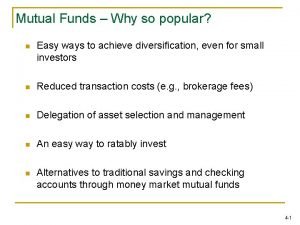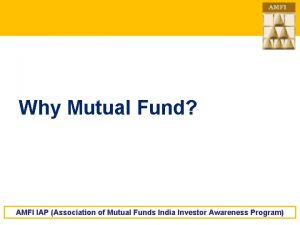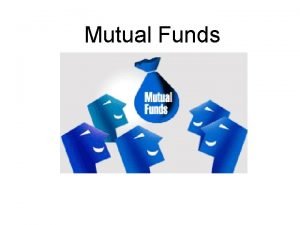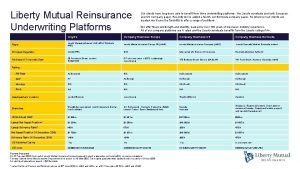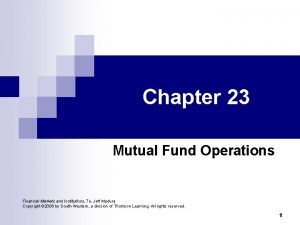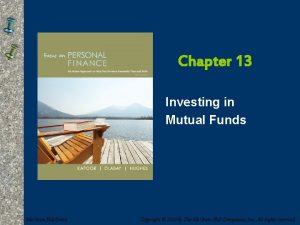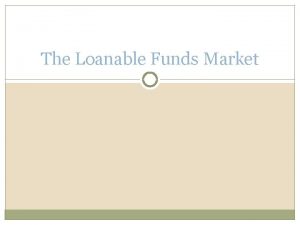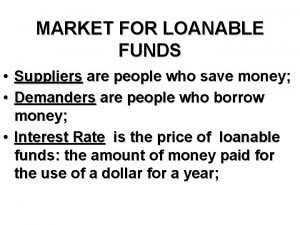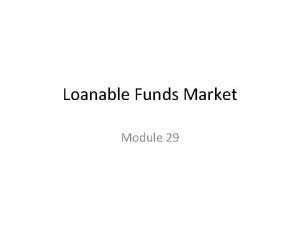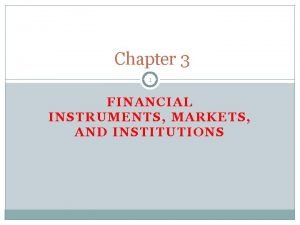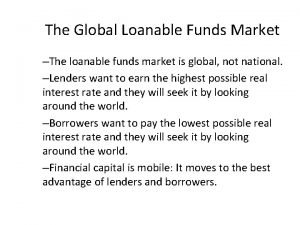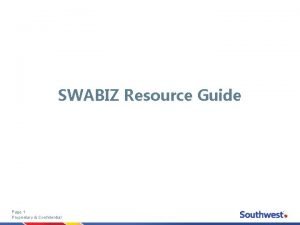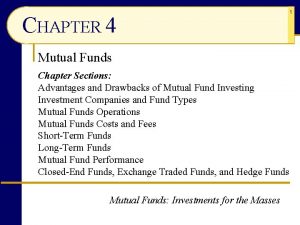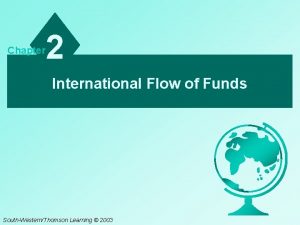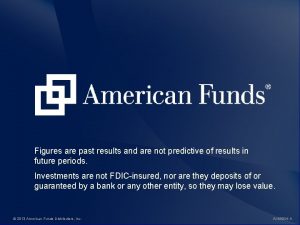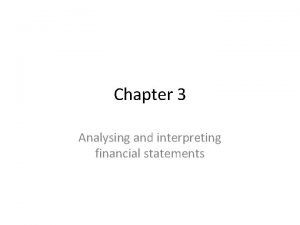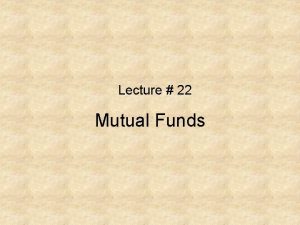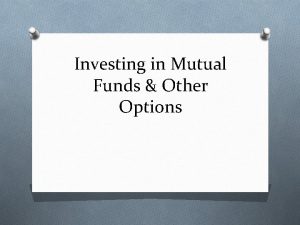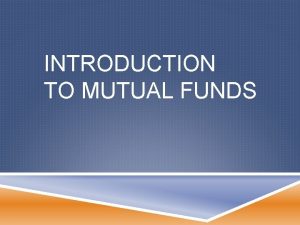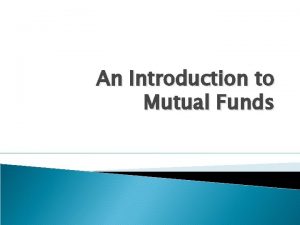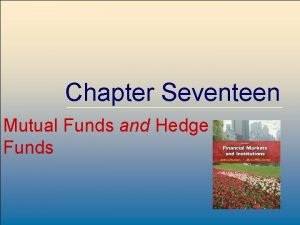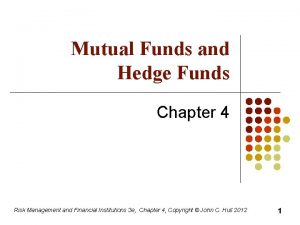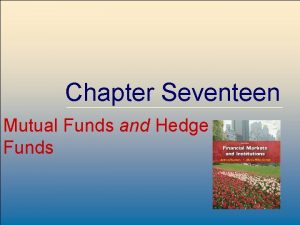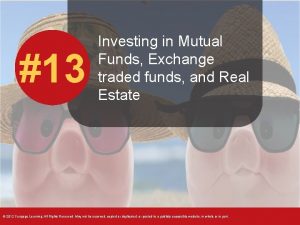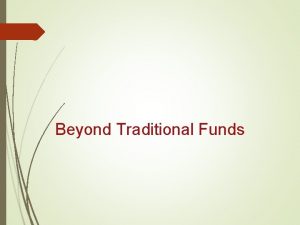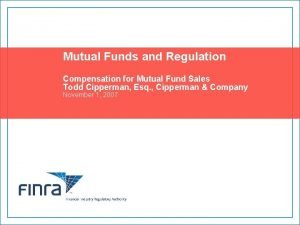An Introduction to What are Mutual Funds Mutual






































- Slides: 38


An Introduction to

What are Mutual Funds? § Mutual funds are a type of investment that takes money from many investors and uses it to make investments based on a stated investment objective. § Each shareholder in the mutual fund participates proportionally (based upon the number of shares owned) in the gain or loss of the fund.

Why do People Invest in Mutual Funds? § Mutual funds offer investors an affordable way to diversify their investment portfolios. § Mutual funds allow investors the opportunity to have a financial stake in many different types of investments. § These investments include: stocks, bonds, money markets, real estate, commodities, etc… § Individually, an investor may be able to own stock in a few companies, a few bonds, and have money in a money market account. Participation in a mutual fund, however, allows the investor to have much greater exposure to each of these asset classes.

Continued § Most mutual funds are professionally managed by an investment expert known as a portfolio manager. § This individual makes all of the buying and selling decisions for the fund. § There are thousands of different mutual funds in the United States. § This provides investors with many options to help them achieve their investment objectives.


Basic Mutual Fund Categories § Mutual Funds can be divided into four basic categories based upon the funds investment objective. § These categories are: 1. Money Market Mutual Funds 2. Stock Mutual Funds 3. Bond Mutual Funds 4. Balanced Mutual Funds

Money Market Mutual Funds

Money Market Mutual Funds § This is the most conservative type of mutual fund. § The goal is to maintain the $1 value of its shares while providing income. § Invests in high-quality, short-term securities such as certificates of deposit, U. S. Treasury Bills, and U. S. Treasury Notes. § MMMF’s are an appropriate place for savings. § These funds have typically offered higher interest rates than bank savings accounts. § Money market mutual funds are not insured by the FDIC.

Stock Mutual Funds § § § Type of fund that invests in stocks. These funds are also known as equity funds. There are many different types of stock mutual funds. § Some of the most common include: Large-cap funds, mid-cap funds, small-cap funds, income funds, growth funds, value funds, blend funds, international funds, and sector funds. § We will take a closer look at each of these different types of stock mutual funds.

Large-Cap Stock Funds § These mutual funds invest in companies with market capitalizations in excess of 10 billion dollars. § Most stocks held in a large-cap fund are from firms with established and profitable businesses. § Large-cap stock funds are less volatile and considered safer than mid-cap and small-cap stock funds. § Large-cap stock funds do not offer as much growth potential as mid-cap and small-cap stock funds.

Mid-Cap Stock Funds § These mutual funds invest in companies with market capitalizations between 2 and 10 billion dollars. § Most stocks held in a mid-cap fund are from firms with established businesses that are still expanding and growing. § These funds tend to offer more growth than large-cap stocks and less volatility than smallcap stocks.

Small-Cap Stock Funds § These mutual funds invest in companies with market capitalizations between 300 million and 2 billion dollars. § Most stocks held in a small-cap fund are from firms with innovative businesses that are still growing and developing. § These funds tend to offer more growth potential than large-cap and mid-cap funds. § However, small-cap stock funds are much more volatile.

Good News! § It is time for us to begin watching a Nightly Business Report Video on Mutual Funds! § With a question sheet of course!

Income Stock Funds § These are also known as equity income funds. § These funds include stocks of companies with a long history of paying dividends. § The major objective of an income stock fund is to provide steady income to investors.

Growth Stock Funds § These funds invest in stocks with the potential for long-term growth. § This means that there is the potential that these stocks will increase significantly in value. § The stocks of companies that are experiencing growth in earnings and revenue are the types of stocks found in growth stock mutual funds.

Value Stock Funds § These funds invest in companies that are thought to be good bargains. § These funds invest in stocks that have fallen out of favor with mainstream investors for one reason or another. § Value stocks are often the stocks of established companies that have stopped growing and that use their earnings to pay dividends. § Value funds produce current income (from the dividends) as well as the potential for long-term growth (from capital appreciation once the stocks become popular again).

Blend Stock Funds § These funds invest in the stocks of companies that are classified as “growth” stocks and “value” stocks. § The growth stocks are designed to provide long-term appreciation in value. § The value stocks are designed to provide dividend income and future growth.

International Stock Funds § These funds include the stocks of foreign companies that are sold in securities markets throughout the world. § International funds may invest in stocks from throughout the world or from a particular nation or region. § Potentially, these funds can provide a tremendous amount of growth, however, they are also considered to be riskier than other types of stock funds.

Sector Stock Funds § Type of fund that invests in a single sector of the economy or industry, such as biomedical research, real estate or precious metals. § Sector funds often generate erratic performance and usually are either at the top or the bottom of the mutual fund performance rankings.

Index Funds § These are mutual funds whose holdings aim to track the performance of a specific stock market index. § The most common index fund tracks the S&P 500. These index funds invest in the exact stocks (and in the same percentages) as those found in the S&P 500. § Index funds have lower costs than actively managed funds.

Bond Mutual Funds § Type of mutual fund that invests in bonds. § There are different types of bond mutual funds. § Typically, bond mutual funds have the objective of providing stable income with minimal risk.

Types of Bond Mutual Funds § We are going to talk about the following types of bond mutual funds: § Short, Intermediate, and Long-Term U. S. Bond Funds § Short, Intermediate, and Long-Term Corporate Bond Funds § Municipal Bond Funds § High-Yield (junk) Bond Funds

U. S. Bond Mutual Funds § Short-Term- invests in T-Bills and TNotes that have maturities of less than five years § Intermediate- invests in government securities that have maturities between five and ten years § Long-Term- invests in government securities that have maturities longer than ten years

Corporate Bond Mutual Funds § Corporate bond mutual funds are also classified by the maturity dates of the bonds held by the fund. They are divided into short-term, intermediate, and longterm. § The same maturity rules apply for corporate bond mutual funds as with U. S. bond mutual funds.

Municipal Bond Mutual Funds § These mutual funds invest in municipal bonds and provide investors with tax-free interest income. § There also insured municipal bond mutual funds. An outside insurance company protects investors from a possible default by the municipality.

High Yield (Junk) Bond Mutual Funds § These mutual funds invest in high yield, high risk corporate bonds. § These are the riskiest type of bond mutual fund. However, these are also the most potentially rewarding type of bond mutual fund.

Balanced Mutual Funds § These are also known as hybrid funds. § These mutual funds invest in stocks, bonds, and money markets. § These are very diversified mutual funds. The stock portion of the fund provides the potential for capital appreciation, while the bond and money market portion provide income.

The Mutual Fund Prospectus § This is a legal document which describes the investment objective of the fund, the manner in which the fund is administered and operated, the fees and other pertinent information. § The prospectus should be read thoroughly before making an investment decision.

Load v. No Load Mutual Funds § A mutual fund that charges a commission to cover its administrative costs is called a load fund. § A front-end load charges the load when the shares are purchased, while a backend load charges the load when the shares are sold. § A no-load mutual fund doesn’t charge a purchase or sales commission.

Major Mutual Fund Companies § Vanguard, Fidelity, and T. Rowe Price are three of the world’s major mutual fund companies. § http: //vanguard. com § http: //fidelity. com § http: //troweprice. com

Let’s review shall we? Get Ready……

Bond Mutual Funds • Would you likely buy it or would I likely buy it? • Why?

Bond Mutual Funds • Would you likely buy it or would I likely buy it? • Why?

High Yield (Junk) Bond Mutual Funds • Why?

• Type of stock • Where is it traded? • Would you likely buy it or would I likely buy it?

• Type of stock • Where is it traded? • Would you likely buy it or would I likely buy it?

What key words do you need to remember when investing? TIME! DIVERSIFY RISK CONSERVATIVE The Key Phrase: l PAY YOURSELF FIRST!
 Antigentest åre
Antigentest åre Mutual funds examples
Mutual funds examples Iap mutual funds
Iap mutual funds Mutual funds disclaimer
Mutual funds disclaimer Mutual funds disclaimer
Mutual funds disclaimer Meritas mutual funds
Meritas mutual funds Reinsurance mutual funds
Reinsurance mutual funds Mutual funds operations
Mutual funds operations Aim mutual funds
Aim mutual funds Mutual funds market watch
Mutual funds market watch Chapter 13 investing in mutual funds
Chapter 13 investing in mutual funds Sources and uses of funds
Sources and uses of funds Financial intermediaries
Financial intermediaries Uab oncology faculty
Uab oncology faculty Loanable funds shifters
Loanable funds shifters Shareholders equity and shareholders funds
Shareholders equity and shareholders funds Funds from operations
Funds from operations Oppenheimer funds hq
Oppenheimer funds hq Module 29 featured worksheet the market for loanable funds
Module 29 featured worksheet the market for loanable funds Supply and demand of loanable funds
Supply and demand of loanable funds Loanable finds market
Loanable finds market Market for loanable funds graph
Market for loanable funds graph Ggof funds
Ggof funds Comparitive statement
Comparitive statement Prime funds calgary
Prime funds calgary Do 8 s 2007
Do 8 s 2007 Financial markets instruments and institutions
Financial markets instruments and institutions Accounting chapter 5 cash control systems answers
Accounting chapter 5 cash control systems answers Loanable funds market graph
Loanable funds market graph Swabiz app
Swabiz app Monetary and fiscal policy interactions activity 5-5
Monetary and fiscal policy interactions activity 5-5 Hartford funds media replay
Hartford funds media replay Fund of funds example
Fund of funds example Agencies that facilitate international flow of funds
Agencies that facilitate international flow of funds National pollution fund center
National pollution fund center American funds mountain chart
American funds mountain chart Commonwealth funds management
Commonwealth funds management Rosf ratio
Rosf ratio Tier 4 maintenance funds
Tier 4 maintenance funds

